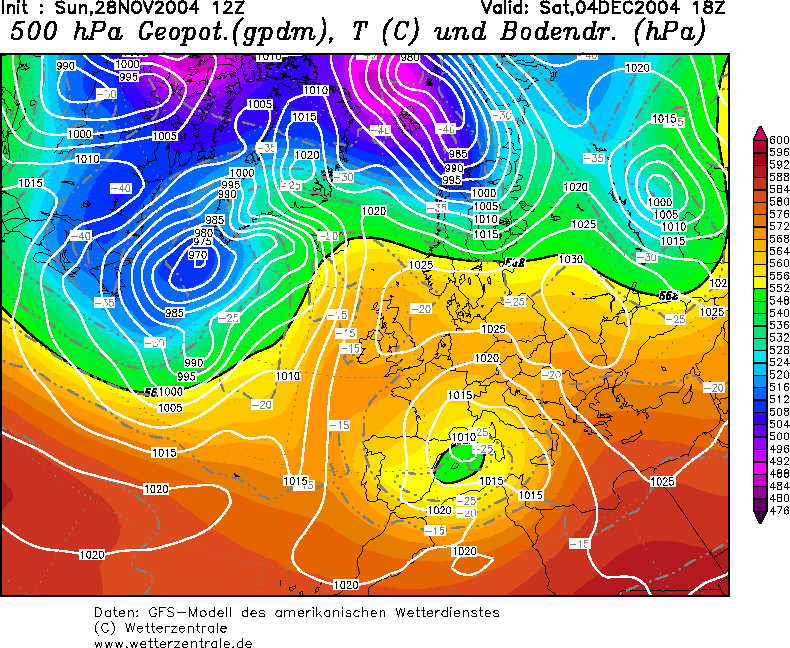Given the preponderance of possible analogs coming up, I believe Winter 2004-05 will see colder than normal conditions in the eastern third to half of the United States and warmer than normal ones in the western quarter to third of the United States. Just to be clear, on a regional scale, I do not believe that cold anomalies will rival those of the extreme Winter of 1976-77. Rather, the figures will probably come out somewhere between those of Winters 2002-03 and 2003-04—probably somewhat warmer than Winter 2002-03 but somewhat colder than Winter 2003-04—particularly in the Washington, DC to Boston region.
The following are a few of the big developments:
Northern Hemisphere/North American Snowcover: The trend continues to be impressive. If such snowcover reaches 34 million or more square kilometers by the end of November--something I expect--the idea of much above snowfall could extend farther south to let's say New York City and Philadelphia.
QBO Reversal: The QBO has briefly moved back to somewhat more positive territory. Consequently, the idea of a postive QBO until at least February or March looks more likely. Earlier, I had anticipated a January-February switch (roughly a compromise between the possibilities were it to have continued to decline or were it to have at least one reversal). ENSO-West (or close to zero) conditions per DT's research could lead to fun possibilities, especially during the February-March period.
PDO Goes Negative: For the first time in 27 months, the PDO dropped below zero in October. I had assumed a positive PDO for the winter. However, the overall idea does not change much in this case. Some of the less attractive possibilities fall by the wayside due to a significantly different QBO situation.
Right now, the PDO seems to be resembling 1958's PDO:
Code: Select all
PDO
Month 1958 2004
May 1.28 0.88
June 1.33 0.04
July 0.89 0.44
Aug 1.06 0.85
Sept 0.29 0.75
Oct 0.01 -0.11
I am not using 1958-59 for a possible analog because its QBO was strongly negative (averaged < -17 for the December-March period). I am using the 1958-59 situation for guidance. This suggests that it is possible that Winter 2004-05 might see the PDO fluctuate between + and -.
Also, in my view, the closest negative PDO analog to 2004-05, assuming it has a negative PDO for the winter, is probably 1963-64: ENSO, QBO, MEI, NAO are all consistent with what I am anticipating.
NAO: At this point in time, I am increasingly confident that the NAO will average below 0 for the December-February and December-March periods. I'll have a final idea once I see the November data.
ENSO Region 1+2: An Ugly Wrinkle?
In recent weeks, Region 1+2's cool anomaly has disappeared and at last word, its anomaly was moving into weak El Niño territory:
Code: Select all
Region 1+2
Week Temp. Anom.
1-Sep-04 20.1 -0.5
8-Sep-04 19.8 -0.7
15-Sep-04 19.8 -0.7
22-Sep-04 20.4 -0.2
29-Sep-04 20.5 -0.2
6-Oct-04 20.8 0.0
13-Oct-04 20.5 -0.4
20-Oct-04 21.4 0.3
27-Oct-04 21.3 0.1
3-Nov-04 21.5 0.2
10-Nov-04 22.0 0.5
Whether or not the ENSO criteria is sustained for a basin-wide ENSO to become official remains to be seen. However, given a wider look at the Pacific, I tend to doubt that this criteria will be maintained as the normal water temperatures continue rise. If I'm correct, as November ends and December begins, the warm anomalies here should begin to shrink.
 The posts in this forum are NOT official forecast and should not be used as such. They are just the opinion of the poster and may or may not be backed by sound meteorological data. They are NOT endorsed by any professional institution or
The posts in this forum are NOT official forecast and should not be used as such. They are just the opinion of the poster and may or may not be backed by sound meteorological data. They are NOT endorsed by any professional institution or 







